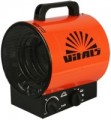The power consumed by the electrical components of the industrial heater during operation.
This parameter allows, first of all, to assess the load on the power grid and the suitability of the available power for the normal operation of the unit. It is relevant for all types of modern industrial heaters (see "Power supply"). However, it is worth noting that in some electric models, the power consumption is indicated for the ventilation mode. In this mode, the heating element is not activated, and the power consumption is extremely low — a few tens of watts. In such cases, the total power can be estimated from the maximum thermal output (see above) — in electrical models, these parameters practically do not differ from each other.
The maximum amount of air that an industrial heater can pass through itself in a certain time.
This parameter is associated with an increase in air temperature (see above): at constant power, higher performance usually corresponds to a smaller temperature difference. Accordingly, a more efficient industrial heater will heat the entire volume of the room faster, but the heating temperature will be lower. So, it is worth choosing according to this parameter, taking into account what is more important for you — a large temperature difference or a high heating rate.
—
Temperature control. The ability to change the heating temperature provided by the industrial heater. This function allows you to optimally adjust the operation of the device to the necessary conditions and heating intensity.
—
Thermostat. A thermostat is a device for maintaining the air temperature at the same level. The principle of operation of this device is as follows: when the required air temperature is reached, it automatically turns off the heating, and when it gets cold, it turns it on again until the air warms up sufficiently. The temperature of the thermostat operation, usually, is set by the operator of the heater.
—
Piezo ignition. The presence of a piezoelectric ignition system in the design of the industrial heater. In such systems, the spark necessary to ignite the fuel is generated by the operation of a piezoelectric generator, and its operation is based on the use of a special material that, when bent, generates an electric current. It means that no external power is required for ignition — the necessary energy is generated by the operator himself when the button is pressed. In addition, piezoelectric systems are considered very convenient for several other technical reasons. They are found mainly in gas industrial heaters (see "Power supply") because, for diesel fuel, such ignition is poorly suited.
—
Complete fuel combustion. This feature is found in gas and diesel models (see "Power supply"). It means that the fuel in the combustion chamber of the heater burns out completely, without forming soot and other by-products and practically without creating unpleasant odours. In addition, it has a positive effect on efficiency. This feature is especially important for diesel units because diesel and many types of liquid fuels are "dirtier" than gas and more prone to soot. Smokeless combustion facilitates the use of heaters in rooms where there are people — however, note that it does not cancel the requirements for good ventilation, since combustion products still need to be removed from the air.
— Fan mode. The ability to operate the heater in the ventilation-only mode, when the device circulates air but does not warm it up. The purpose of this function is obvious: situations when the room is already warm enough, or heating is not required for other reasons.
— Fuel level indicator. The presence in the design of a diesel heater of a sensor that signals the amount of fuel in the tank. The design and operation of this sensor may vary from model to model: in some devices, it constantly displays the remaining fuel; in others, it plays the role of an alarm and turns on only when the fuel level drops below a certain value. However, this feature makes it easier to monitor the condition of the unit and prevents troubles associated with unexpected emptying of the tank.
— Air filter. The presence of an air purification filter in the design of a diesel heater. One of the “weaknesses" of such units is the nozzles that supply the fuel-air mixture to the combustion chamber; contaminants that enter these nozzles clog them and can even disable them. The air purification filter prevents such troubles: it traps dust, sand and other mechanical impurities, ensuring stable operation and durability of the injectors.
The ability
to change the tilt angle of the industrial heater. Thanks to this, you can adjust the direction of the air flow not only horizontally (by turning the unit), but also vertically — for example, direct heat to the wall section that needs to be dried first.

